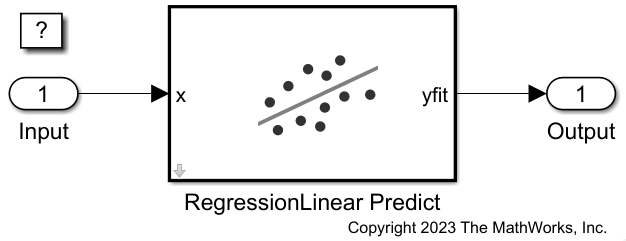RegressionLinear Predict
库:
Statistics and Machine Learning Toolbox /
Regression
描述
RegressionLinear Predict 模块使用线性回归对象 (RegressionLinear) 预测响应。
通过指定包含经过训练的回归对象的工作区变量的名称,将该对象导入模块中。输入端口 x 接收一个观测值(预测变量数据),输出端口 yfit 返回该观测值的预测响应。
示例
端口
输入
输出
参数
模块特性
数据类型 |
|
直接馈通 |
|
多维信号 |
|
可变大小信号 |
|
过零检测 |
|
详细信息
替代功能
您可以将 MATLAB Function 模块与线性回归对象 (RegressionLinear) 的 predict 对象函数结合使用。有关示例,请参阅Predict Class Labels Using MATLAB Function Block。
在决定是使用 Statistics and Machine Learning Toolbox™ 库中的 RegressionLinear Predict 模块还是具有 predict 函数的 MATLAB Function 模块时,请考虑以下几点:
如果使用 Statistics and Machine Learning Toolbox 库模块,可以使用定点工具 (Fixed-Point Designer)将浮点模型转换为定点。
必须为具有
predict函数的 MATLAB Function 模块启用对可变大小数组的支持。如果使用 MATLAB Function 模块,您可以在同一 MATLAB Function 模块中的预测之前或之后使用 MATLAB 函数进行预处理或后处理。
扩展功能
版本历史记录
在 R2023a 中推出


